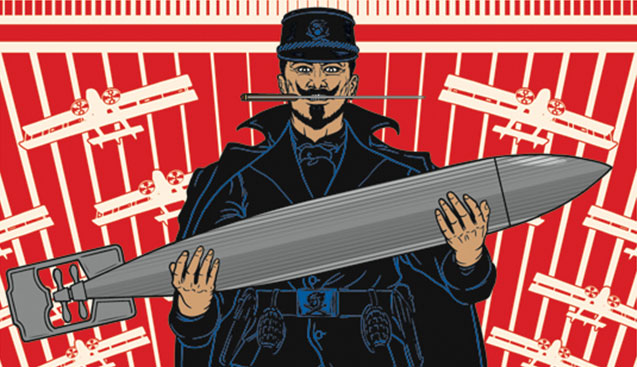(1) EL-MOHTAR LAUNCHES. This week Amal El-Mohtar took up her duties as sff reviewer for the New York Times “Otherworldly” column: “The Latest in Science Fiction and Fantasy”.
…Del and Sofia Samatar are siblings, and MONSTER PORTRAITS (Rose Metal, paper, $14.95) is a dialogue between Del’s art and Sofia’s words that is equal parts exploration, investigation and meditation about monsters and monstrosity. From the title I expected something like a bestiary, where the text would build fictions out of the art to pen (as it were) the creatures into a mythology — but this book is nothing so simple or straightforward; it is, if anything, an anti-bestiary, organized around the systems that produce bestiaries. Most of the portraits describe an author’s encounters with the creatures depicted, encounters that spark real-world musings on race and diaspora, framing the often contradictory ways in which we represent, consume or reject monstrosity. It’s a book of discomfort, of itching beneath the skin — which dovetails beautifully with the fact that Del Samatar works as a tattoo artist, and that many of the images in this book are easily imagined inked onto bodies….
(2) ARE THEY NEEDED? Rafia Zakaria speaks “In Praise of Negative Reviews” at The Baffler.
“Startlingly smart,” “remarkable,” “endlessly interesting,” “delicious.” Such are the adulatory adjectives scattered through the pages of the book review section in one of America’s leading newspapers. The praise is poignant, particularly if one happens to be the author, hoping for the kind of testimonial that will drive sales. Waiting for the critic’s verdict used to be a moment of high anxiety, but there’s not so much to worry about anymore. The general tone and tenor of the contemporary book review is an advertisement-style frippery. And, if a rave isn’t in order, the reviewer will give a stylized summary of sorts, bookended with non-conclusions as to the book’s content. Absent in either is any critical engagement, let alone any excavation of the book’s umbilical connection to the world in which it is born. Only the longest-serving critics, if they are lucky enough to be ensconced in the handful of newspapers that still have them, paw at the possibility of a negative review. And even they, embarking on that journey of a polemical book review, temper their taunts and defang their dissection. In essence they bow to the premise that every book is a gem, and every reviewer a professional gift-wrapper who appears during the holidays.
It is a pitiable present, this one that celebrates the enfeebling of literary criticism, but we were warned of it.
(3) FRIED GREEN TOMATOES. Scott Edelman invites Eating the Fantastic listeners to “Gobble fried green tomatoes with Thomas F. Monteleone”.
I don’t know which meal you’re getting ready for wherever you happen to be, but here at Eating the Fantastic world headquarters, it’s time for lunch at the Mountain Branch Grille & Pub with Thomas F. Monteleone, a five-time winner of the Bram Stoker Award, who’s published more than 100 stories since his first one appeared in Amazing back in 1972.
My first fictional encounter with him, though, wasn’t until 1975, when his first novel, Seeds of Change, became the debut title for the famed (or infamous, depending on how you look at it) Laser Books science fiction line, and in this episode you’ll get to hear all about the serendipity which made that sale happen.
He’s accomplished so much since those early sales that last year, the Horror Writers Association honored him with its Lifetime Achievement Award. He’s also a highly opinionated guy, as is proven by his ongoing no-holds-barred column The Mothers And Fathers Italian Association, a collection of which won the 2003 Bram Stoker Award for Non-Fiction …and is also proven by this episode.
We discussed the tricks he teaches to transform writers at his famed Borderlands Bootcamp, the 200+ rejections he received before he finally made his first fiction sale, how Theodore Sturgeon helped him realize it was possible for him to become a writer, why he ended up as a horror icon after his big start in science fiction, which horror writers you want on your team when you’re choosing sides for softball, the reason his live readings have become legendary, how Peter Straub reacted when Tom put him on his list of most overrated writers, how a challenge from Damon Knight changed his life, and much more.
(4) ADAPTATION AND ANNIHLATION. At Lit Hub, Jeff VanderMeer and Christina Sibul talk about “What’s It Really Like to Have Your Book Made Into a Movie”.
JV: . . . But with regard to the monster [in Annihilation], I think what I was after in the books was to destabilize the usual reveal. The reason it’s gradual is to kind of acclimate you so when you actually finally see it you notice more than just the horror and surprise of it but the beauty and the strangeness of it as well. And I think Garland [the director of the Annihilation adaptation] gets there a different way. He’s still thinking about the same things, and in many ways, it’s a very loose translation of the book. But you can see many points where he is translating, where he is reacting to something in the book, and so I do think that in the third act of the movie where you do see the crawler—and you don’t see it before that—he somehow manages visually to get the horror and beauty of it by being very precise.
The thing I found fascinating is on the set visit they had what I would call a three-act structure of the visual imagination. Like, literally on the walls all around this building they had just pasted photographs and pictures, some of which they found and some of which they created as, like, what is the tone and texture of this part. And for the third act, several of the images they had that were inspiration for the monster were the same things that I’d come up with during my research, but we had not communicated about this. They had just come to it through parallel evolution. So, I think that the depiction of the crawler is very accurate in some ways. And very horrific and beautiful at the same time. There’s another monster too in there because there’s the moaning creature in the books, and the moaning creature he translated into this strange bear that also combines aspects of the boar that’s in the book. So, there’s another translation of the monster where someone may see it and say, “That’s not from the book,” but in actual fact it kind of is, you know
(5) COMICS SECTION.
- John King Tarpinian and I are old enough to get the visual references in Heathcliff. Maybe you are, too.
- And this Dracula joke in Speedbump is pretty dumb, but I laughed.
(6) THE GOODBYE BATGIRL. Yesterday I read somewhere “Joss Whedon Drops Out of Batgirl”. Adam-Troy Castro won’t miss him: “Joss Whedon Quit the BATGIRL Movie For All The Right Reasons”.
Joss Whedon has stepped down from scripting duties on a proposed BATGIRL movie, saying he just couldn’t come up with a story.
I suspect he had some other reasons, some of which speak well of him and some of which don’t, but that’s a boring subject. (So is whether there should be a Batgirl movie, period. Let’s just say that my personal enthusiasm at this point, is limited. We have more than enough movies in this genre, thank you.)
But let us talk of his stated reason for having so much trouble with the character: paraphrased, he couldn’t think of a reason why this girl’s head would be so messed up she would start doing this thing.
And instantly you know that he doesn’t get the character at all and that stepping away was a good thing.
You see, the premise that a person’s head must be “messed up” in some way to become a hero in this genre is based on only a very few examples.
(7) DEATH OF THE MIGHTY THOR. Jane Foster’s time as The Mighty Thor may be coming to an end. And in this case I don’t think that’s a spoiler.
For more than three years, Jason Aaron has been building Jane Foster’s story to its epic conclusion – and it all comes together in Mighty Thor #705! This March, don’t miss the final chapter of Thor’s journey, written by Jason Aaron and drawn by Russell Dauterman, as Mangog’s rampage threatens to bring about the end of Asgard as we know it – and the Goddess of Thunder herself.
(8) COMICS BUYER. Daniel P. Dern sends a link to io9’s “Ordering Physical Comics Books Is About to Get Slightly Easier”, which says Diamond’s new Pullbox will simplify (pre)ordering your hardcopy comics from your comic store.
It’s not completely digital—you still have to go and physically collect your orders from your local store, after all, so if you’re looking to avoid the potentially intimidating act of heading into a comics store, Pullbox isn’t the solution.
Dern comments: “I’d like to think that not all comic stores are intimidating, e.g., certainly not <shoutout>The Outer Limits, in Waltham MA</shoutout> (where I’ve been a customer since it opened back in 1983). A larger concern, I’d guess, would be the decreasing # of comic shops, as in, (not) having one near (enough). Yeah, you can mail-order, but not the same experience.
“I’m happy that it sounds like this new service isn’t trying to disintermediate the stores, but rather work with and within them.”
(9) CREATIVE TEAM BEHIND BLACK PANTHER. Calgary comic book scholar Michael Hoskin offers a roundup of all the comic book creators who had a hand in the Black Panther movie. He makes a compelling case that Christopher Priest (the first full-time black writer at Marvel comics) should be getting more credit for what was seen on screen: “Black Panther (2018) creator credits”.
(10) EXPANSE. Syfy dropped The Expanse Season 3 teaser trailer.
(11) GONE FISHING. The industry has a surprising amount of coverage: “New Maps Reveal Global Fishing’s ‘Vast Scope Of Exploitation Of The Ocean'”.
The maps show the most intense fishing activity along the coasts of heavily populated areas like Europe and China. But fishing also covers much of the high seas. According to the researchers, commercial fishing operations covered at least 55 percent of the world’s oceans. That area, it calculates, is four times larger than the area devoted to agriculture on land.
The researchers also were able to distinguish between fishing vessels from different countries. According to the study, five countries — China, Spain, Taiwan, Japan, and South Korea — accounted for 85 percent of all high-seas fishing.
The BBC also has a summary.
(12) TOUGH TO KILL Jurassic Dead is coming to theaters. Run away!
PLOT: A cracked scientist aligns with the Axis of Evil to bring down the US of A with EMP blasts, toxic zombification gas and an unleashing of the ultimate undead killing monstrosity — the Z-REX. When a hot-wired militia squad and a crew of college hipsters are thrown together to do something about it, chaotic Predator-Thunder action runs amok.
(13) THE REAL FUTURE OF AI. On the Nextnature blog, Menno Gutfeld and Koort van Mensvoort interview Bruce Sterling about how bodies will become mechancially augmented in the future and when artificial intelligence will become sentient: “Interview: Bruce Sterling on the Convergence of Humans and Machines”.
Lots of people are actually talking about and also investing a lot of money in this idea of convergence of the machine and humans. What are your thoughts on this?
That convergence will not happen, because the ambition is basically metaphysical. It will recede over the horizon like a heat mirage. We are never going to get there. It works like this: first, far-fetched metaphysical propositions. Then an academic computer scientist will try and build one in the lab. Some aspect of that can actually be commercialized, distributed and sold.
This is the history of artificial intelligence. We do not have Artificial Intelligence today, but we do have other stuff like computer vision systems, robotic abilities to move around, gripper systems. We have bits and pieces of the grand idea, but those pieces are big industries. They do not fit together to form one super thing. Siri can talk, but she cannot grip things. There are machines that grip and manipulate, but they do not talk. You end up with this unbundling of the metaphysical ideas and their replacement by actual products and services. Those products exist in the marketplace like most other artifacts that we have: like potato chips, bags, shoes, Hollywood products, games.
(14) VIDEO OF THE DAY. In “The (End) of History Illusion)–Miu Miu Women’s Tales” on Vimeo, Celia Rowlson-Hall describes the fabulous future after atomic attack, where you can live in a bunker wearing swell clothes from the 1950s and eat all the canned carrots you want!
[Thanks to John King Tarpinian, JJ, Cat Eldridge, Chip Hitchcock, Martin Morse Wooster, Olav Rokne, Carl Slaughter, Daniel P. Dern, and Andrew Porter for some of these stories. Title credit belongs to File 770 contributing editor of the day Joe H.]




